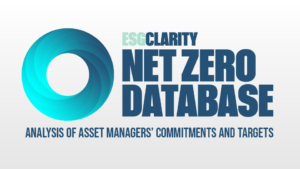A number of sustainable strategies have become oversimplified and aren’t driving real-world impact, Roman Cassini, head of ESG at Hosking Partners, told ESG Clarity in this latest Green Dream video interview.
He explains why sustainable funds are positioning themselves in low-carbon intensity companies or sectors, but this is not driving change at the pace the world needs.
He also discusses why different asset classes need to have different labels when it comes to sustainability and the difference between investing in public and private equities from an ESG perspective.
Watch the full video interview above and read the transcript below.
NK: Hello and welcome back to the Green Dream video series. I’m here today with Roman Cassini, head of ESG at Hosking Partners. Thanks so much for coming in. Can you tell us a bit about what you do there and what does Hosking Partners do, what they’re known for?
RC: Hosking Partners is a boutique asset manager based in London and, at the moment, we have about $6bn assets under management and we offer a single long-only global equity strategy to primarily institutional investors.
My role is head of ESG, so I have one foot in the investment team helping support the portfolio managers, conduct engagement on behalf of the companies that we own ] with the PMS. And then my other role is in the client services team. So speaking to our clients and helping them understand how we think about some of these complicated issues.
NK: In my research, I noticed that you said that the summer ESG strategies are becoming oversimplistic and leading to a misallocation of capital and actually working against the energy transition? Could you explain that? How did you come to that conclusion?
RC: Clearly this is an extremely complicated issue and we don’t really claim to have any monopoly on insight here, and there’s a lot of really interesting discussion about this by all sorts of commentators from across the asset management industry and the wider regulatory environment as well.
Our view on this is that it’s what I like to refer to as the great asset class discrepancy. The approach to sustainable investing generally is asset class blind – it doesn’t matter whether you’re investing in public equities or public debt or private debt or private equities or real estate or anything. The approach to sustainability has been the same. Broadly speaking, but 80% of sustainable strategies use divestment. Regardless of which asset class you’re in, the idea is, well, if you just stop investing in industries that we think are dirty or working against our sustainable goals in one way or the other, then that achieves your aim.
The issue we see with this is that we don’t think all asset classes were created alike when it came to sustainability. We’re public equities investors, we think the issue is predominantly in public equities. The connection between owning or not owning a share and a company that’s already been issued and real-world impact is very tenuous. And there’s a lot of really interesting studies that have been done on this. But the big picture conclusion is we don’t really know whether it causes real world impact.
It’s certainly not well proven impact funds themselves…So the Global Impact Investors Network [has found] only 4% of the assets under management at an impact fund are invested in public equities because impact funds themselves recognise that you don’t drive real world change by real world public equities. It’s possible if you own concentrated positions in a small number of companies, and then you lever that to apply change at board level.
But it’s really difficult to do so if you’re a diversified equities product, which I would say probably the majority of asset managers out there are, if you’re claiming to be selling some kind of sustainable strategy that’s achieving a real world impact, be that towards climate change or biodiversity or water usage or anything else, and you’re doing it by owning or not owning certain areas of the public equities market, we just don’t think you’re really achieving very much impact at all.
See also: – ESG changed my mind on…sustainable investing being about real-world change
And that’s where the misallocation of capital comes in because capital is being driven towards these strategies because they’re so well known, they’re so popular, there’s so many of them, and because capital is going so much there… if you imagine I’m an investor, I’m in a supermarket aisle of my options and I want to put some of my pension towards sustainability, 80% of the supermarket aisle, these diversified public equities funds, are saying, ‘hey, we’re sustainable, we’re going to charge you a slightly high management fee because we’re sustainable and you can have this great effect’… if you actually ask questions about how they are actually achieving that effect, it is really difficult to prove. And so capital is being taken away from real impact funds that are generating real evidence impacts, but also capital is being taken away from unconstrained funds that don’t have a sustainable strategy, who are just saying, ‘look, we’re going to try and leave you as a pensioner in 50 years’ time with as much capital as possible’.
NK: Yeah, that makes sense. Thank you for explaining that. And just to touch on that point about concentration, a few years ago when there was this boom and people were interested in ESG, parts of the industry were criticised because a small pool of funds were being pushed into a narrower pool of companies because of the ESG credentials. Are we still there? Have we moved on from that?
RC: Well, I mean, it’s an interesting question. I think the issue is more perhaps to do with the types of companies which exhibit certain characteristics which have become associated with sustainability are not necessarily the types of companies which actually have the most potential to drive some of these sustainability objectives, like decarbonisation.
So, a simple example is if you’re a big tech company and you know your business is producing software, your carbon emissions are going to be very low structurally because of the nature of the industry you’re in. On the flipside, if you’re a cement company and you’re providing cement into the emerging world required for that emerging well, to industrialise and urbanise again structurally because of the nature of the industry you’re in, your carbon emissions are going to be really high. Cement makes up about 8% of global carbon emissions. Where the market’s been in the last 10 years, and particularly the last four years as sustainable investing has become such a theme, the market is already heavily concentrated towards tech and often large-cap tech, which naturally has a low carbon intensity anyway.
If that concentration in the market starts to unwind, which history tells us that to some extent at least it will, then a lot of these metrics where people are saying, ‘Oh look how impressive this portfolio is because it’s really low carbon intensity’ that’s hiding the fact that actually those strategies are just really overweight in some of these asset light, carbon light parts of the market.
If you really want to generate impact, I argue actually perhaps you want to be looking at some of the dirtier parts of the market, the parts of the market that actually have the most to offer for decarbonisation rather than denying them capital. So to take cement as an example, if you’re if you’re in a sustainable strategy, it’s unlikely that that strategy is heavy in cement because cement is a dirty industry. But we’d suggest, you know, cement is not going anywhere. What cement needs to do is figure out how to produce the same or similar cement at a lower carbon intensity. To do that, it needs capital to fund R&D because we don’t have the technology to do it yet. There’s a Catch 22 situation where the companies that most need money to decarbonise are being denied it for the very reason that they’re not decarbonise today.
NK: So moving on to this from the fund perspective, where we have in the UK, that is still where FCA is trying to label these funds as improvers up to impact. What do you think about that? What do you think needs to be changed bearing in mind your comments on impact in the other questions.
RC: Broadly speaking, I think that the FCA’s approach is, is not bad.
I think it’s better than some regulatory agencies. Sacha Sadan, the director of ESG [at the FCA] I’ve seen speaks several times and I think he kind of gets it. The problem with those labels, as I see it comes back to this asset class point, which is that they’re the same. It doesn’t matter whether you’re a private equity fund or a public equity fund. Broadly, you can apply for the same the same labels. So in my view, the bar that needs to be reached to, for example, justify a ‘sustainable impact’ label for a public equities fund should be far higher than it is for a private equity fund, because I think just the fact is that it’s so much harder to generate real world impact via owning public equities than it does is by owning real estate or private equity or private debt.
My comment to the FCA would be there needs to be more discrimination between the different asset classes that these strategies are using in order to justify the application of these labels. But I support the intent of what they’re doing, which is to cut down on impact washing and greenwashing, which should be the priority.
NK: Absolutely. Okay. We always end the Green Dream with this question. What’s your favourite sustainable drink or snack?
RC: My favourite sustainable drink… Have you heard of a company called the Small Beer Company? I gather that they are the first brewery in the UK that’s a B Corp – an accredited sustainable business.
And but what I really like about them is they make beer that’s about 2.8%. And I feel that there’s a bit of a gap in the market between alcohol free beer and like 5% imported lager. And if I go to a pub quiz on a Thursday, I want to have three pints, but I don’t want to have three pints of 5% lager so I can get up for work on a Friday. I think that they’ve nailed this middle ground of you’ve got a little bit of a kick, but not too much of a hangover. Plus, is it sustainable.
NK: I like that one. Thank you very much for your time today.








